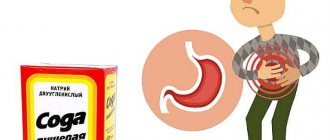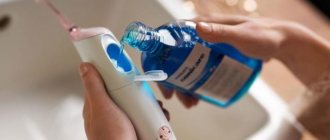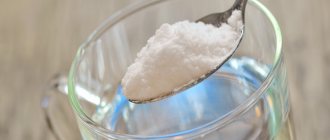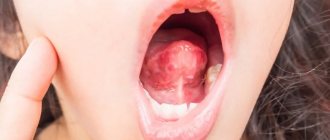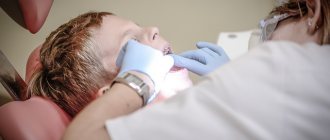Antibacterial compounds play an important role in maintaining oral hygiene. They are necessary to destroy bacteria and reduce pain. A solution of soda, salt and iodine is by far the safest and most affordable means of preventing many dental diseases. Rinsing helps to cope with aching, acute pain, and in some cases even relieve swelling near the gum pocket.
Sodium bicarbonate has many positive properties. Its use prevents the development of carious manifestations and inhibits pathological processes. You can even remove tartar using baking soda powder. Quite often they rinse their mouth with soda after resection of an element of the dentition has been performed or nerve endings have been painfully removed. Antibacterial compounds accelerate the regeneration of soft tissues and have a disinfecting effect.
Indications for rinsing with a solution of soda and salt
As a preventive procedure, it is recommended to rinse with sodium bicarbonate, as this has the necessary antimicrobial effect. The main indications for rinsing with soda and salt in the required proportions:
- Dental diseases. Gingivitis, stomatitis, periodontal disease and other pathologies in which the gum canal is damaged.
- Hygienic. Aimed at removing food debris and plaque from hard-to-reach areas.
- Therapeutic and prophylactic. Rinsing your mouth with soda can also be done as a preventative measure.
All therapeutic rinses must be performed only after consultation with a doctor. Only a dentist can determine whether in your case it is possible to rinse your mouth with soda, salt and iodine. This procedure has certain contraindications, so improper use can lead to deterioration of health and significant harmful effects.
How to rinse your nose correctly?
Many people are hesitant to try the procedure on themselves, mistakenly believing that this manipulation is very complicated. At first, it may not be entirely comfortable, but after several sessions, you will get used to it and will cope with it with ease.
There are several ways to rinse the nasal cavity. Let's look at the most common ones:
- The easiest way is using an ordinary pipette: you need to take a few drops of the solution into the pipette and drop it into each nasal passage one by one, tilting your head back. Hold your head like this for a few seconds, then blow out the contents of your nose. This manipulation must be repeated several times. You will immediately feel how much easier it is to breathe.
- Another method involves using a small kettle as a rinsing device. Pour the solution into the kettle and tilt your head to the side, place the spout of the kettle in your nostril and carefully pour the liquid into it. According to the principle of communicating vessels, liquid will flow out of the second nostril. Then repeat the same procedure, but on the other side. During the procedure you need to breathe through your mouth. If you don’t have a suitable kettle at hand, you can use a syringe or syringe without a needle.
- Another well-known method is to pour the washing liquid into a saucer and draw it in with your nose, but do not swallow. Spit out the liquid and repeat the procedure.
Types of rinsing solutions
- Soda. Sodium bicarbonate has a good antifungal effect, soda is effective as a prophylaxis against gum inflammation. It is recommended to add a teaspoon of the chemical element to a glass of warm boiled water. The advantages of the solution include the fact that it gently cleanses the oral cavity and tooth enamel and has a good disinfectant effect.
- Salt. Saline solution is a good antiseptic. To prepare, dilute a spoonful of salt in a glass of warm water. Salt promotes rapid healing of cracks and wounds, soothes the diseased element of the dental system.
- Soda-salt. The use of soda-salt solution is the most effective therapeutic and preventive method. In this case, mix a teaspoon of soda and salt in a glass of warm water. The best option when the first symptoms of various dental pathologies appear.
- Soda-salt with iodine. An indispensable assistant in solving various dental problems. It is necessary to rinse your mouth with iodine, salt and soda in the right proportions. Half a teaspoon of soda and salt and a drop of iodine are diluted in warm water. Everything is thoroughly mixed. It is used as a prophylaxis for bleeding gums and for the treatment of all kinds of inflammatory processes.
We looked at how you can make soda-salt baths using various additional components. Today there is a wide variety of solutions, but it is necessary to consult a specialist. Following the doctor’s recommendations will help prevent drying of the mucous membrane, increased sensitivity of the enamel and other negative phenomena.
Rules for the procedure
In order for rinsing to be beneficial, you need to adhere to certain rules3 in the use of ready-made preparations and the preparation and use of solutions from them.
- The proportions of the components must be strictly observed. The question “how much baking soda to gargle” is perhaps one of the most popular on the Internet. It disappears if you use ready-made pharmaceutical preparations that no longer need to be diluted with water - these are the ones most often recommended by doctors.
- The solution should not be cold or hot - only warm3,4. For this reason, there is no need to keep medications in the refrigerator.
- Follow the instructions for the duration of the procedure - this ensures the necessary contact of the active components of the drug with the mucous membrane3.
- Follow the manufacturer's recommended frequency of treatments to ensure continuity of treatment. The components of the drug retain their activity at the site of inflammation for a limited amount of time.
- Try not to swallow the product. Of course, there will be no poisoning in any case, but still, rinsing preparations are not intended for oral administration.
- For half an hour after the procedure, drink nothing and do not eat food3,4. This is important to prolong the contact of the drug with the affected mucous membrane.
Up to contents
How to rinse with baking soda correctly
It is recommended to follow these simple guidelines:
- Hygiene. Thoroughly clean the elements of the dental system from dirt and food debris.
- Temperature conditions. It is recommended to use cooled boiled water, as boiling water can cause injury to the gum tissue, and too cool water can lead to discomfort.
- Features of rinsing. It is necessary to keep the solution exactly in the place where the pain is localized.
- Interval. It is necessary to rinse your mouth with soda, salt and iodine at least three times a day, in some cases more often depending on the doctor’s recommendations. The procedure itself should last from 3 to 6 minutes.
If you don’t know what to rinse your mouth with or how to prepare the solution, consult your doctor. This is especially important to do if you have an allergic reaction to sodium bicarbonate or have any contraindications. As prescribed by a doctor, a decoction of chamomile, oak bark or sage can be prescribed.
Possible dangers of nasal rinsing
Despite the apparent versatility and accessibility of this method, it has certain contraindications. Rinsing the nose with saline solution should not be carried out if a person has:
- deviated nasal septum;
- polyps, cysts and other formations in the nose and nasopharynx;
- tendency to frequent nosebleeds;
- allergies to certain components of the washing liquid;
- inflammatory process in the nasopharynx.
In the latter case, rinsing the nose at home is not only ineffective, but even a dangerous method of treatment. The structure of our ENT organs is such that they are interconnected, and if the manipulation is carried out incorrectly, the infection can spread, for example, from the maxillary sinuses to the ear and cause severe inflammation in it. As we see, home conditions are not always conducive to safe medical procedures. Therefore, at the slightest suspicion of inflammation in the nasopharynx, immediately contact an otolaryngologist.
Rinsing teeth with soda: benefits and harms
A properly prepared solution has an antimicrobial effect and helps prevent the pathological process associated with the destruction of enamel, dentin, and pulp chamber. It relieves pain, reduces the severity of the inflammatory process, and can be used to whiten teeth. Its use as a prophylactic agent will help make tooth pain weaker and the patient’s condition much more comfortable.
In some cases, the soda-saline solution should be abandoned. For example, in cases of thyroid dysfunction, nephritis and tuberculosis, the use of iodine is contraindicated; this also applies to cases of lactation and pregnancy. More complete information about contraindications can be obtained by talking to a specialist.
It must be emphasized that soda and salt can be used in complex therapy only as a preventive measure. If the pain does not go away and throbbing pain is diagnosed, you should immediately visit a doctor. Specialists of the Alpha Dent clinic are ready to provide high-quality dental services and advise on the use of soda solutions. The right approach will allow you to achieve the desired effect and avoid complications.
What's the benefit?
The use of saline solution has long established itself as an excellent preventive and therapeutic agent that helps prevent the development of airborne diseases. The solution disinfects, cleanses the nasal passages, preventing the further spread of pathogens, and relieves swelling. The procedure itself cannot be called too pleasant, but the therapeutic effect is obvious, the main thing is to carry out the washing itself correctly. This method can be used for nasal congestion in children, as well as for pregnant women.
The main components needed to prepare the solution are salt and water. Ready-made saline solutions based on sea salt can be purchased at any pharmacy, for example, the preparations “Aqualor”, “Aquamaris”, “Dolphin” - all these are convenient and effective devices for carrying out the procedure of sanitation of the nasal cavity at home. But a saline solution with a similar therapeutic effect can be prepared at home.
For what diseases is soda solution used?
The substance will help with any damage to the pharynx caused by an infection. However, it is necessary to clarify in what cases a simple gargling with soda will help and to characterize common diseases.
Laryngitis
Appears if the mucous membrane of the larynx is inflamed. Typically, laryngitis is mild (the infection does not spread to the tonsils, so there are no complications).
The cause of laryngitis is normal hypothermia or infection. However, symptoms often appear due to overstrain of the ligaments.
Laryngitis is a cyclical disease. It may come back over time. But if the source is an infection, the body will be able to fight it.
If people have bad habits, such as smoking or drinking alcohol, laryngitis will return constantly. Alcohol and tobacco smoke burn the mucous membrane, causing inflammation.
Pharyngitis
Appears if a person has been exposed to cold air for a long time and inhaled it. The tissues of the pharynx became inflamed. The source of pharyngitis is not an infection (rather normal hypothermia).
The first symptom of pharyngitis is a mild sore throat (it cannot be confused). If it appears, treatment should be started immediately, otherwise serious complications may occur.
There are cases when people become infected with a virus that causes pharyngitis. The latter works even in warm weather and causes unexpected inflammation.
Pharyngitis is a disease that is often asymptomatic (except for a sore throat). It is unpleasant because with the wrong approach, the disease does not leave a person for several months.
Angina
One of the most common diseases that appears unexpectedly. Among the listed diseases, it is considered the most dangerous, since it is accompanied by an increase in temperature, sometimes reaching 40 degrees.
Sore throat is difficult to confuse with other lesions. The greatest risk of getting infected is during an epidemic (it is better to stay away from crowded places and do not go to large shopping centers).
You can become infected through airborne droplets. However, in extreme cold it does not pose a danger (this only applies to being outside).
It’s not a sore throat that’s scary, but its consequences. If treatment is incorrect or untimely, pus will begin to fall out of the tonsils, which harms the kidneys, heart and other internal organs. The complication leads to disruption of their work. As a result, organs are not always able to cope with their functions.
Stomatitis
It is an inflammation of the oral mucosa. Stomatitis can be identified by small ulcers. They are formed in the following places:
- Tonsils.
- Cheeks (inner sides).
- Lips.
There are many factors that provoke the formation of stomatitis:
- Infection.
- Allergy.
- Increase or decrease in hormone levels.
- Stress.
- Chemicals in toothpaste.
Dry cough
It usually appears when the throat and nasopharynx are affected. Using the solution would be appropriate, because the disease is not too serious. However, if the cough produces sputum, a comprehensive approach will be required, including taking medications, since the cause is more likely to be related to the lungs.
FAQ
- Do not rinse your mouth on the first day after wisdom tooth removal!
Is it acceptable to rinse your mouth with baking soda after wisdom tooth removal? After wisdom tooth removal, severe pain may persist for some time. But, even despite this, within 24 hours after the manipulation, the oral cavity cannot be rinsed with any solution, since there is a high risk of washing out the protective blood clot from the socket at the site of the extracted tooth. After the specified period, you can rinse.
- Is it possible to rinse an open tooth? Open tooth is a condition that involves opening the tooth to remove the nerve. In this case, rinses are prescribed to provide an antiseptic effect. It is allowed to use a solution of soda.
- What is better for procedures – saline or soda solution? Both of these solutions are effective, but each of them is suitable for a specific case. Baking soda has a greater antiseptic effect, while salt has a healing effect.
- Why is antiseptic treatment of the oral cavity necessary after tooth extraction? After tooth extraction, the treated area remains vulnerable to various infections until healing. To prevent the development of the inflammatory process, you should rinse your mouth with antiseptic solutions.
- How to make soda baths for teeth? Dental baths are a procedure that is almost no different from rinsing. A distinctive feature is the need to keep the solution in the mouth, between the gum and cheek, for up to 40 seconds. In one session, you need to repeat the manipulation up to 4 times a day.
Why is regular salt replaced with sea salt?
Some dentists advise taking baths and rinsing sore teeth with a solution of baking soda and sea salt. The fact is that this product contains an increased amount of iodine, which has an antimicrobial effect. In addition, this salt helps strengthen tooth enamel.
To prepare a healing solution for tooth pain, you need to take 1 tsp. soda and sea salt and dilute them with 250 ml of warm water. To strengthen the enamel of teeth, it is enough to rinse sensitive teeth with a mixture containing 1 small spoon of bulk product and half a glass of water.
To weaken the effect of pathogenic microbes living in the oral cavity and remove heavy odor, you can rinse your mouth with a solution of soda and hydrogen peroxide. To make the medicine, take 250 ml of heated water and add 3 tbsp. l. 3% peroxide and 1 tbsp. l. sodium bicarbonate without a slide. The mixture is thoroughly stirred and used for therapeutic rinsing of the mouth. It is not recommended to take the drug internally or use it for any other therapeutic purposes.
Despite the beneficial properties of salt, iodine and soda, medicinal mixtures based on them can only be used as first aid or auxiliary treatment. If acute pain or inflammation occurs, you should contact your dentist as soon as possible and begin therapy aimed at eliminating the cause of the disease.
Tips for use
To ensure that the treatment does not harm, you must adhere to the following rules:
- Prepare only one portion of the mixture and apply it immediately.
- Take only warm water. Cold intensifies the disease, and hot will burn the tissue.
- Carry out the event only after eating. Do not consume anything for 1 hour.
- Completely dissolve the ingredients in water. It is better to pour hot water into a glass and wait until it cools (the substance dissolves faster in hot water).
- Do not rinse for more than 30 seconds at a time.





